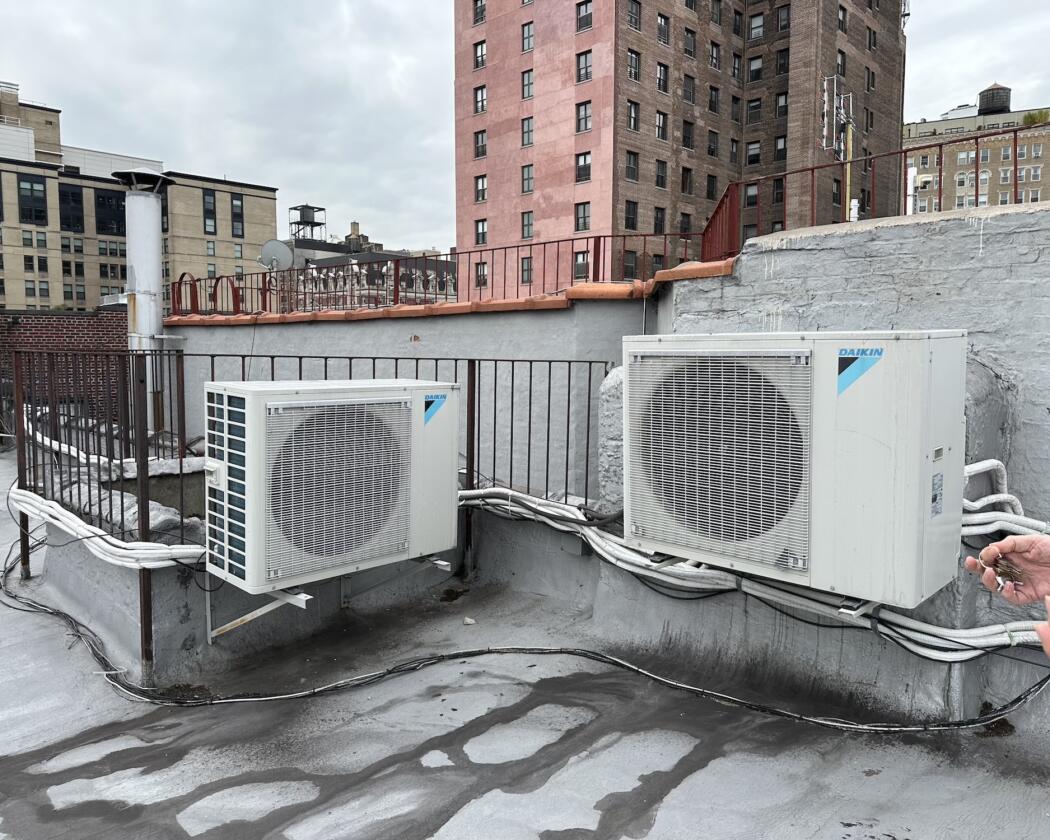
Controlling for comfort — and for cost
New air-source heat pumps offer residents an increased level of control, but also shift who’s paying for the heat
Heat pumps installed on the roof of this five-story building bring thermal energy from the outside down into residential units, offering residents a greater degree of control of their apartment’s temperature. Photo: Otis Miller
Resident Lisa Harrison uses a hand-held remote control to turn the heat down a few degrees, adjusting the temperature to her exact liking. The slight humming sound emanating from the Daikin unit in her dining area stops, but heat keeps flowing steadily in.
Comfort was once elusive in Harrison’s multi-family building. Residents had to layer up or move space heaters from room to room. But with the new heat pumps they’ve had since 2020, all it takes is a touch of a button to achieve a level of comfort that was previously unthinkable.
“Everyone loves having control,” said Harrison.
The co-op’s Daikin heat pump systems are made up of a series of indoor and outdoor units connected by a network of refrigerant and electrical lines. The outdoor units pull air in through a large L‑shaped heat exchanger. The heat pumps then extract the thermal energy from inside the apartment, if they’re operating as air conditioners in the summer — or, if they’re acting as heaters in winter, they absorb what little heat there is from the outside air and move that heat inside the building.
While increased comfort and control are the most tangible benefits for residents, the heat pumps also reduce energy use. As Jon Hacker, Daikin’s former Energy Efficiency Business Development Manager, put it, efficiency is “engineered into the system.” This is done with inverters, which use an algorithm to adjust the motor speed and provide cooling and heating at the minimum power consumption, rather than turning off the unit and then turning it back on, which makes it work harder to achieve the desired temperature.
“The lower the percentage is, the more efficient the system works,” Hacker said. “So if I could run my heat pump at 50 percent and maintain comfort, that’s way better than running it [at] 100 percent.”
As residents modulate heat pump use, they’re also learning about how it affects their budget: Harrison found that her electrical bills are significantly more expensive in the cold winter months than they were pre-heat pumps. In February 2020, for example, she spent $68.56 on electricity, whereas the following February she spent $260.82 — about a 280 percent increase.
“Comfort does come at a cost,” Daikin’s Hacker said.
Lisa Harrison said seeing her electricity bill does make her more conscious of her energy use. She has always been in the habit of keeping her heat off at night; now, with the heat pumps installed, this practice can reduce energy use in the long run, according to a Taitem study.
The study, conducted from December 2023 to April 2024, asked residents to manually “set back” the temperature a few degrees for approximately 8 hours each night. According to the preliminary results, the nighttime setback reduced heating energy use by approximately 30 percent per apartment. Five units total participated.
“The biggest lesson is that ‘set it and forget it’, which is often recommended by installers and institutions like utilities or funding sources, is out of date,” said Betsy Parrington, the vice president of Taitem. “Night setbacks save energy for heat pump systems.”
Moderating heat pump temperature is not an exact science. But generally, Hacker said, best practice would be a “moderate setback” of a couple of degrees if residents plan to be away from their home for more than eight hours, and a “deep setback” if they’ll be gone for a longer period of time.
For curious residents who want a breakdown of their electricity use, Con Edison ‘Smart Meters’ in the building’s basement provide detailed feedback in 15-minute intervals. In theory, having access to this granular data combined with electricity bills will offer residents even more information and control over their systems, and induce them to use less, Sahagian said.
“That’s one of the things that I insist on with this kind of a project, because if you don’t have that feedback mechanism, then people just leave it on all the time,” he said.
